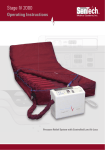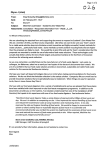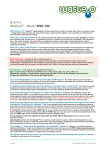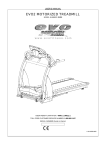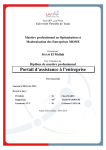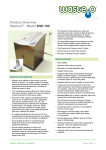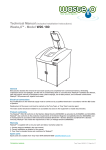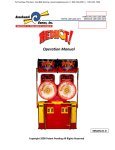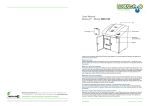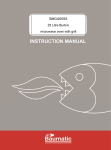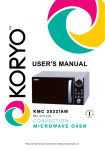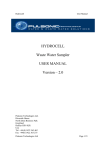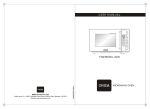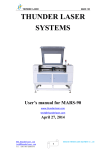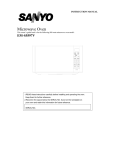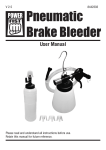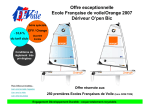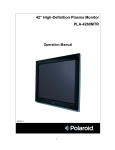Download Waste 2 0 Food Waste Digester
Transcript
Q & A’s Waste20TM - Model W20.180 What does it do? Waste20TM rapidly digests soft food waste and converts it into grey water which runs away to drain - simply throw in the food and walk away. The process is called aerobic digestion, and a naturally occurring blend of microorganisms help with this process. What can I put in the machine? The machine will take soft organic food waste such as fruit, vegetables, cooked and uncooked meat, fish and so on. The general rule is that if a human can eat the food, the Waste20TM will process the food. The machine and the microorganisms are designed to process a wide range of food waste types in mixed quantities. If your operation disposes of a a large large quantity of one one type type of of food food waste, waste, contact contact Tony Mechline forfor advice before operating the machine. of quantity of Team advice before operating the machine. What can’t I put in the machine? The machine cannot process anything that is not soft organic food waste and cannot be easily broken down such as bones, seeds and stones, flower stems, packaging, general waste, cutlery, crockery etc. The general rule is that if a human cannot eat the product, then Waste20TM cannot process the product. This is important because placing the wrong products into the machine could cause damage and could void the warranty. What stays out: - inorganic or fibrous materials such as: Bones, wrappers/packaging/styrofoam, plastics, dishes (crockery or cutlery) napkins/serviettes, flower stems, oil/fats/grease, soup/liquid stock, raw dough/flour, yeast, pineapple tops, corn husks or other heavily fibrous materials, fruit seeds & stones (such as mango, avocado, peach, etc.), frozen or chilled food (wait until room temperature). What goes in: - soft, organic, bio-degradable food such as: Raw or cooked meat, poultry, fish, vegetables, fruit, noodles, bread, pasta, rice, dairy, coffee, etc. NB: just like a person - do not put too much of any one kind of food into the machine at any one time. A balanced combination of food waste will digest better. If anything accidentally drops into the machine, is it safe to fish it out by hand? Yes. There is a paddle mechanism inside the machine that slowly rotates to stir the food waste, but this automatically stops as soon as the machine lid is opened. Rubber gloves should always be worn when retrieving anything from inside the machine. How much soft organic food waste can I put in the machine? Operators can continually “top up” the machine with food waste - up to 45kgs at any one time. A general rule-of-thumb is to fill up to the axle. Much like the human digestive system, the machine gradually processes the food. Trying to put too much food waste into the machine at one time will overload the machine and slow the process. Note: Excessive overloading will cause the machine to shut down. The machine can process a maximum of 180kgs of soft organic food waste over a 24-hour period. What if my operation has a period of the day when a significant amount of soft organic food waste is produced - lunchtime for example? This is very common and is easily overcome by scheduling the loads of food waste put into the machine. Food waste in excess of what the machine can process at any one time should be stored ready to be put into the machine later in the day once the machine has had a chance to process what it already holds. If the Waste20TM control panel’s amber ‘WAIT’ light is on, the machine has sensed that it is working at full capacity. Note that the Waste20TM lid will automatically lock while the ‘WAIT’ light is on. As soon as the machine has digested some of its load, the ‘WAIT’ light will go out and the machine lid will automatically unlock. Do not attempt to force the machine lid open while the ‘WAIT’ light is illuminated. Doing so could void the machine warranty. Operational tip: Every time the Waste20TM lid is opened, a small amount of power, water and microorganism is used. Try to minimise the number of times the machine lid is opened by keeping a sealable food waste bucket by the machine. Open the machine lid and pour in the food waste only when the bucket is full. Can Category 1 food waste be digested by the Waste20TM machine? Category 1 is not allowed to go to landfill and therefore, it would not be allowed to be digested and sent to drains. As per DEFRA (http://www.defra.gov.uk/food-farm/byproducts), certain destinations, upon return, have their waste deemed as international catering waste (Cat 1). Cat 1 waste has to be incinerated or rendered under the highest controls. Q & A’s DPV Revision: 07/2011 l Page 1 of 3 Waste20TM - Model: W20.180 What is the BOD, COD and suspended solid count for the grey water output from the machine? Grey water, in its very nature, is waste water containing a percentage of organic materials, and it can be the typical discharge from kitchen sinks, showers, baths, etc. The amount of organic material in the waste water will depend on what was being washed. The output from Waste20TM machines will vary according to what is put inside the machine. And the results can vary daily, depending on the food waste for the day. Ultimately, it is the client’s responsibility to determine the suitability of the product before ordering and that installations and operations comply with local authority guidelines. Have you any details on how often during the day food waste can be loaded into the unit, e.g. can 180kgs be loaded into the machine in one go, how long would it be before it can be used again and how much extra would it be able to take? The machine can process a maximum of 180kgs of soft organic food waste over a 24-hour period. Operators can continually “top up” the machine with food waste - up to 45kgs at any one time. A general rule-of-thumb is to fill up to the axle. If the machine is overloaded, the shot bolt will activate. It is almost impossible to gauge when the next load will be ready, as it depends what kind of food waste went in. Some food groups take longer to digest than others. If the ‘WAIT’ light comes on each time you “top up” with food waste, then you are constantly overloading the machine and this could reduce the life span of the machine. How do I put food waste into the Waste20TM? Simply open the machine lid and pour the food waste through the hatch onto the woodchips inside, then close the lid. Why are there woodchips in the machine The woodchips are impregnated with specially blended microorganisms that break up the food waste. The woodchips Team will contact you months remain in the machine all of the time and only need topping up every 12 months. Tony Mechline will contact you 1212 months after your Waste20TM has been installed to arrange for more woodchips to be delivered. Can I put refrigerated or frozen food waste into the Waste20TM? No. Please allow for the food waste to come to room temperature before adding. If very cold food waste is added it will change the conditions in the chamber and could kill the microorganisms that break up the food waste. Is there any sludge or by-product for me to get rid of? No. All of the soft organic food waste will be digested by the machine and will run away to drain as grey water. Is there anything else I need to do to keep the Waste20TM machine running at it’s best? Yes. You must ensure that there is always a box of Waste20TM microorganism in the machine and that the box is properly connected. This is essential because every time the machine hatch is opened a tiny amount of the microorganism is sprayed onto the food waste. If the microorganisms are not regularly topped up in this way, they will eventually die out and the machine will not be able to function. If the machine lid is opened approximately 25 times per day, the fluid box will last approximately 30 days. If the lid is opened more frequently, the fluid box will require replacing sooner. The microorganisms have been specially blended for this application and are perfectly safe. The Material Safety Data Sheet for the microorganisms is included with each master box, and there is a copy in the user’s manual for your records. When the fluid requires replacing, the blue ‘REPLACE FLUID’ light on the control panel will flash and a buzzer alarm will sound. NOTE: If the fluid is not replaced within 72 hours of the alarm sounding, the lid will automatically lock, and will not release forfor release until until the the fluid fluid box box is replaced. replaced. Follow Follow the the replacement replacement instructions instructions on on the the fluid fluid box. Contact Mechline Tony Team replacement replacement fluid fluid 01908 01629 261511. 813859.Always Alwayskeep keepaaspare sparebox boxininstock. stock. Water connections must be 1/2-in BSP, with permanent (24-hour) warm water supply @ 50°C between 2-5 bar pressure. Maximum hardness 70mg per litre. NB: If 50°C water supply is not available, consider installing at least a 50L, 3Kw, dedicated water heater. Drain connections must be 42mm (1 1/2-in) at approx 425mm AFFL. Only use swept waste fittings with a maximum of 4 fittings between the machine and the soil & vent or floor drain. Ensure connection is to foul water drain. Do not fit trap. Appliance is trapped internally. Do not use compression, push-fit, short or close fittings. Installation must be carried out in accordance with local authority requirements. Water supplies require appropriate back flow prevention. Minimum recommended wall gap to rear of appliance 90mm. Allow a reasonable gap for a service engineer to also access the side panels. Installation should be in a well ventilated area. What if the red ‘SERVICE’ light flashes? The ‘SERVICE’ light will flash and the alarm will sound if the machine shaft becomes jammed. If this happens, open the machine lid and remove the cause of the jam. Rubber gloves should be worn for this operation. The machine shaft will not run until the lid has been closed. What if there is a power cut, or someone turns off the power to the machine, or someone presses the emergency knock-off button? Waste20TM will not automatically restart. Once the power is restored, follow the procedure: 1. Turn the isolator on the front of the machine to the ‘ON’ position. 2. Ensure the emergency knock-off switch is pulled out. 3. Press the green ‘RESTART’ button on the control panel. The machine will now restart. NOTE: The ‘WAIT’ light will illuminate and the lid will remain locked for 20 minutes while the machine warms up. After 20 minutes the machine can be used in the normal way. What if the machine is left unused for a long period of time? If the Waste20TM machine is not used (lid is not opened) for 96 hours (4 days and nights,) it automatically reverts to ‘ENERGY-SAVING’ mode. Opening and closing the lid will return the machine to normal running mode. NOTE: If the machine is not used (lid is not opened) for 1 month, the microorganisms inside the machine chamber will die. In this situation a ‘BOOSTER PACK’ of microorganism must be added to the machine chamber before the machine is used. ‘Booster packs’ can be purchased from Tony Mechline 01908 261511. Team DPV Revision: 07/2011 l Page 2 of 3 Q & A’s Waste20TM - Model: W20.180 Can all the contents of the tank, e.g. woodchips, etc., be removed through the top hatch? Yes; this is actually the only way out of the chamber. How do I take care of the machine? The machine should only be regularly wiped down using a disposable cloth and plain warm water. Do not use bleach, anti-bacterial agents or other harsh cleaning chemicals. Never pour floor washing or cleaning water into the machine as the presence of cleaning agents may kill the microorganisms. Do not turn off the power or water supply to the Waste20TM. The machine should be left running. Max Temp of Hot water service? If 60 degrees, will it need a thermostat fitted? Yes; a thermostatic mixing valve will be required, set to 50 degrees. Does the unit come fitted with a check valve or will that have to be provided externally? One must be provided externally. Will/could the unit freeze up if it is located outside, even if it is under cover? There is a danger of this. The machine must not be installed outside, it must be covered by a fully rain-proof shelter and protected from temperatures no lower than 5°C and no higher than 40ºC. Avoid inserting food that is frozen or very cold. It is best to let it come to room temperature. If the unit is located in a separate room, what extract rate will be required? Or will a extraction fan be adequate? It is always worth getting decent ventilation into the area; we have units that have operated with both standard ventilation and just a fan. The aim is to get approximately 15-20 air changes, but some sites are less than this. It is for each site to determine how best to provide working conditions suitable for its operators and employees. Does the unit have to be drained down for maintenance purposes? No; in fact it does not have a tank or hold any water, with the exception of the drain pump and water latent in the food waste, which would be dispersed before servicing. What height does the drain outlet have to be and what type of open floor tundish, gulley, etc.? The drain exit from the machine is around 405-435mm off the ground (dependent of how high the adjustable feet are set to). Ideally the drain is discharged into a trapped floor gully. Does the room require a wash down gulley? This is a decision for the client, but it would help to run the drain outlet and a wash down gulley together, giving the ability to wash down the room, especially given that there may be spillages of food waste, etc. What clearance is required around the unit (off the adjacent walls, etc) for access to the service outlets? Minimum recommended wall gap to rear of appliance 90mm. Allow a reasonable gap for a service engineer to also access the side panels. How to determine the capacity of waste/number of units required to cater efficiently for the number of covers served in a catering facility? The calculation is more a rule-of-thumb as each establishment will differ. Usually outline the following: If you use a range of 0.2kgs to 0.4kgs PER COVER, the lower being where you think there is good control, the latter where it is a more expansive menu i.e. more wastage. For example a restaurant does 100 lunches, 50 breakfast and 250 evening meals, with a total of 400-covers, and it is a broad menu, we have 400 x 0.4kgs=160kgs per day. They may then tell you that they have food waste pick ups twice a week at £85 per lift, giving a monthly charge of approximately £680 per month and an annual charge of £8,160.00. Also, consider costs for black bin liners, as operations could spend £30 per month double bagging food waste. How much water is required per day, each time it is loaded? 600litres is the daily usage. The water usage is pretty consistent over the day; however, there will be a slight increase during operational hours, as this is when the lid is being opened. So if 600litres per day is the maximum draw, it will use about 25litres per hour on average. This will increase slightly during operation and be less than that during the night. Will methane gas build up in the machine? This is not a cause for concern. Only a trace amount of methane is produced which is flushed away down the drain. What happens to the food waste inside the Waste20TM? Why not derive energy from the waste? Through an aerobic process, the machine contains enzymes that digest the food and starts the breakdown of fats and greases, resulting in carbon dioxide and water. About 75% of food waste is water anyway so all the water going back into the sewer system is a good thing. A local company could take the food away and use the same aerobic process to reduce the food to biomass to burn for energy, but heavy, wet food waste is very energy intensive to dry out so why incur the extra costs? Alternatively a local company could use anaerobic digestion (AD) to convert the wet food into methane for energy production but some waste water companies, including Thames Water, already use this process themselves. So it’s possible the grey water from the Waste20TM could already be feeding into an energy-producing process. But in these commendable schemes to derive energy from food waste, not only are the processes energy intensive but the food waste still requires collection from site -- using fuel to get it to its factory, which would almost certainly use electricity in the process. With the Waste20TM, all the food waste disposal is done right next to where the food was prepared. Although there is still some biological content in the water output, this is very much lower than if the food had been mechanically chopped up, macerated or just flushed down the drain and after all, the sewers are designed to take biological waste. The important thing is that an operation is doing something to divert its food waste from landfill where it would form methane that could escape into the atmosphere which is far worse for the environment than carbon dioxide. The manufacturer hasinbeen in close contact Thames Water and otherauthorities authorities to Mechline has been close contact withwith Thames Water and other toensure ensuredue duediligence. diligence. Q & A’s DPV Revision: 07/2011 l Page 3 of 3 Product Overview Waste20TM - Model W20.180 ● The bacteria in the product are safe and naturally occurring, classed as Hazard Group 1; they could boost the population of “good” bacteria in the system for beneficial effects further downstream ● The formulation begins the breakdown of Fats, Oils & Grease (FOGs) to help minimise the chance of blockages further down the drain ● Fluid replacement approx every 30 days ● Annual top up of wood chip required ● One-year warranty for parts & labour SPECIFICATIONS ● CE-certified ● Stainless steel external panels ● Mounted on height adjustable legs ● Integral drain pump ● Supplied with starter bioenzymatic fluid pack (approx 3-month supply) - subsequent fluid boxes (enzyme replacement) are sold separately as master boxes of 3x 5-Litre packs ● Supplied with first year’s supply of wood chips ● Locking service access panels to the front where electronics and enzyme replacement box are situated. Left panel is key locked for easy access to fluid boxes. Right panel uses a service lock to restrict access to the electronics ● Moulded MDPE top is impact resistant, with inset access lid for food waste insertion ● The lid locks down when fluid box is empty. There are also visual and audible indicators to notify of replacement box requirement ● Lid will also lock if machine is overloaded to assist correct usage ● Unit requires 10-amp supply, with 15mm (1/2-in BSP) hot (warm) water feed. 42mm (1 1/2-in) drain ● Overall dimensions 1095mm wide x 1015mm deep x 1435mm high ● Permanent (24-hour) warm water supply 50°C required. Services supplied by others ● Must drain to foul water drain ● Optional extras and recommended equipment available PRODUCT INFORMATION ● Digests up to 180kgs of food waste, over the course of 24-hrs – no organic solids to manage. Maximum performance and machine capacity is dependent on food temperature, schedule of filling and types of food ● The resulting grey water (effluent) is safe for drains and sewer systems. Output will vary according to volume and type of food waste added ● Only insert soft, organic, bio-degradable food, such as raw & cooked meat, fish, vegetables, fruit, pasta, noodles, bread, rice, etc. and avoid heavily fibrous materials (like vegetable & fruit husks), raw dough, yeast, etc. Avoid adding excessive amounts of coffee grinds. These foods will require conventional disposal. See User’s Manual for details ● ● ● For optimal performance, do not over fill. It is recommended to top up food waste, up to 45kgs, over a 6 hour period. The 45kgs is a guideline Avoid putting in frozen or cold food waste. Keep food waste at room temperature for optimal performance Do not subject machine or fluid to low temperatures. Care must be taken to provide adequate cover for the machine and protection from temperatures no lower than 5°C and no higher than 40ºC PRODUCT OVERVIEW / DATA SHEET DPV Revision: 04/2011 Data Sheet Waste20TM - Model W20.180 Water Supply: A. Water connection 1/2" BSP. Power Supply: C. Power connection 10-amp 1 ph. Permanent (24-hr) warm water supply at 50°C between 2-5 bar pressure. Maximum hardness 70mg per litre Machine supplied with 1.5m cable and moulded 3pin plug NB: If 50°C water supply is not available, consider installing at least a 50L, 3Kw, dedicated water heater ● Minimum recommended wall gap to rear of appliance 90mm. Allow a reasonable gap for a service engineer to also access the side panels ● Recommended for installation in a well ventilated area ● Installation must be carried out in accordance with local authority requirements ● Water supplies require appropriate back flow prevention Drain Connection: B. Drain connection 42mm (1 1/2") at approx. 425mm AFFL. Only use swept waste fittings with a maximum of 4 fittings between the machine and the soil & vent or floor drain. Ensure connection is to foul water drain. Do not fit trap. Appliance is trapped internally. Do not use compression, push-fit, short or close fittings. Machine weight: Machine capacity: 230kgs, with no food waste. Requires installation on a level base 180kgs of organic waste material, every 24-hours. Approximate water usage 600-litres (0.6m3) per 24-hours Supplied: Waste20TM machine, including delivery. Approx 3-month supply of fluid and one year’s supply of wood chips. NB: Installation not included. Electrical & water services supplied by others On-going supplies required: Part No: W20.EPAK Fluid packs (enzymes), sold in Master Boxes of 3-off, 5-litre packs for regular maintenance (each 5-litre pack lasts approx 30 days, depending on site conditions) Part No: W20.RECH Annual re-charger pack for top up of wood chips Recommended equipment: Part No: W20.ZIP50 Zip 50-litre localised continuous hot-water heater, wall mounted To help ensure the required 50°C water supply temperature is achieved. (Installation not included) Tony Team Ltd Unit 6, Station Road, Bakewell, Derbyshire DE45 1GE T: 01629 813859 F: 01629 814334 E: [email protected] www.tonyteam.co.uk Dimensions shown in mm unless otherwise stated. Information and numerical data has been prepared as a general guide to the products but intending buyers & users must satisfy themselves as to the suitability and safety of the products for their particular purposes & duties. No responsibilities are assumed for errors herein. The company reserves the right to alter designs and specifications of the products without notice.





